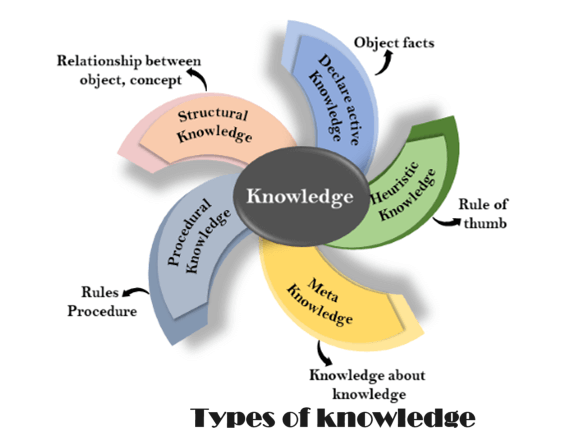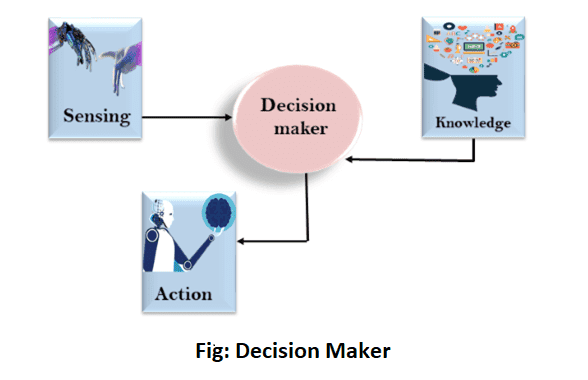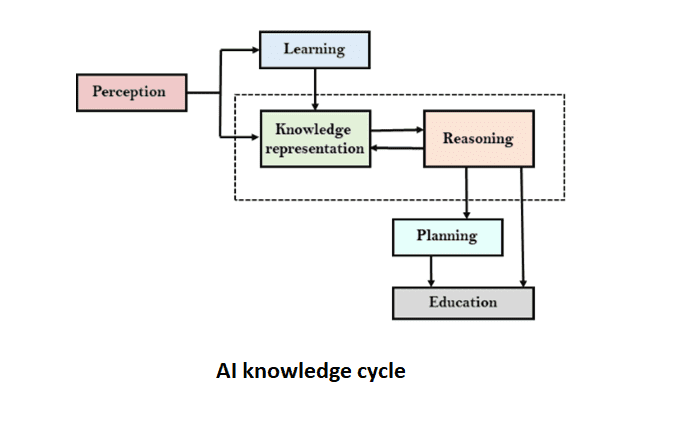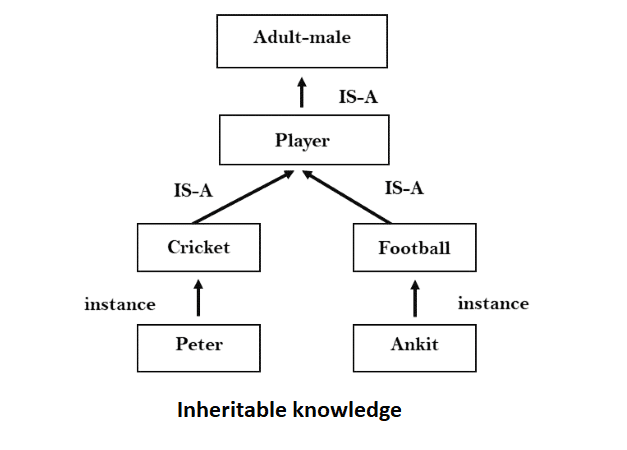Knowledge Representation in AI
Table of Content:
- What is knowledge representation in AI?
- What to Represent?
- What is knowledge in AI?
- The relation between knowledge and intelligence.
- AI knowledge cycle.
- Approaches to knowledge representation.
- Simple relational knowledge.
- Inheritable knowledge.
- Inferential knowledge.
- Procedural knowledge.
- Requirements for knowledge Representation system.
Content Highlight:
Knowledge representation in AI is the cornerstone of intelligent systems, enabling them to understand, reason, and solve complex problems. It involves encoding real-world information in a format understandable by computers, facilitating tasks such as medical diagnosis and decision-making.
- Various approaches, including relational, inheritable, inferential, and procedural knowledge, cater to different types of data and reasoning.
- A robust knowledge representation system must accurately capture diverse knowledge types, facilitate inference and learning, and efficiently acquire new information to drive intelligent behavior.
What is knowledge representation in AI?
Knowledge Representation and reasoning (KR, KRR) is a fundamental aspect of Artificial Intelligence (AI), focusing on how AI agents think and process information to exhibit intelligent behavior. At its core, Knowledge Representation involves encoding information about the real world in a format understandable by computers.
Through effective Knowledge Representation, machines can comprehend and utilize knowledge to tackle complex problems, such as medical diagnosis, natural language processing, and decision making. By representing knowledge in AI systems, we enable them to learn from experiences and make informed decisions, akin to human cognition.
With advances in Knowledge Representation techniques, AI systems can interpret data, extract meaningful insights, and derive solutions to intricate real-world challenges. Whether it's understanding human language, recognizing patterns, or making decisions based on available information, Knowledge Representation forms the backbone of AI's problem-solving capabilities.
What to Represent:
Knowledge representation in AI encompasses various types of information essential for intelligent systems. Here's a breakdown:
- Objects: Facts about objects in the world domain. For example, "Guitars contain strings" or "Trumpets are brass instruments."
- Events: Actions occurring in the world.
- Performance: Descriptions of behaviors involving knowledge of how to do things.
- Meta-knowledge: Knowledge about what we know.
- Facts: Truths about the real world and its representations.
- Knowledge Base (KB): The central component of knowledge-based agents. Represented as a group of sentences, where "sentences" have a specific technical meaning rather than being identical to everyday English language sentences.
What is knowledge in AI?
In AI, knowledge refers to information or data that an artificial intelligence system possesses and utilizes to perform tasks or make decisions. This knowledge can be structured or unstructured and is often acquired through learning algorithms, experiences, or explicit instructions provided by human programmers.
Types of knowledge:
The various types of knowledge are as follows:

- Declarative Knowledge: Declarative knowledge involves understanding concepts, facts, and objects. It's expressed in declarative sentences and forms the foundation of understanding about something.
- Procedural Knowledge: Procedural knowledge, also known as imperative knowledge, pertains to knowing how to do something. It encompasses rules, strategies, and procedures that can be directly applied to tasks.
- Meta-knowledge: Meta-knowledge refers to knowledge about other types of knowledge. It provides insight into the nature, organization, and application of different knowledge types.
- Heuristic knowledge: Heuristic Knowledge represents insights from experts in a particular field or subject. It's based on previous experiences and approaches, often taking the form of rules of thumb that guide problem-solving but aren't guaranteed to be optimal.
- Structural knowledge: Structural Knowledge encompasses fundamental knowledge essential for problem-solving. It elucidates the relationships between various concepts and objects, such as classifications, part-whole relationships, and groupings.
The relation between knowledge and intelligence:
Knowledge of the real world plays a vital role in intelligence, both in human cognition and in creating artificial intelligence. In AI, knowledge is crucial for demonstrating intelligent behavior in agents. An agent can only accurately respond to input when it possesses relevant knowledge or experiences.
For instance, imagine encountering someone speaking a language you don't understand. Without knowledge of that language, you would struggle to interact intelligently. Similarly, AI agents rely on knowledge to make informed decisions and exhibit intelligent behavior.

AI knowledge cycle:
For showing intelligent behavior, an artificial intelligence system must have the following components:
- Perception: The AI system perceives its environment, gathering information through sensors or other means.
- Learning: Through various techniques such as supervised learning, unsupervised learning, or reinforcement learning, the AI system acquires knowledge from data.
- Knowledge Representation and Reasoning: The acquired knowledge is represented in a suitable format and used for reasoning to make decisions or solve problems.
- Planning: Based on the knowledge and goals, the AI system devises a plan of action to achieve desired outcomes.
- Execution: The AI system executes the planned actions, interacting with the environment to achieve its objectives.

The diagram above illustrates how an AI system interacts with the real world and the key components that enable it to demonstrate intelligence. The AI system has a Perception component, which retrieves information from its environment, including visual, audio, or other forms of sensory input.
The Learning component is responsible for acquiring knowledge from data captured by the Perception component. In the complete cycle, the main components are Knowledge Representation and Reasoning. These two components are involved in demonstrating intelligence in machines similar to humans. They are independent but also coupled together. The Planning and Execution components depend on the analysis of Knowledge Representation and Reasoning.
Approaches to knowledge representation:
There are basically four approaches to knowledge representation, which are:
1. Simple relational knowledge:
Simple Relational Knowledge is a straightforward method of storing facts, employing the relational approach where each fact about a set of objects is systematically laid out in columns.
This approach to knowledge representation is widely used in database systems, where relationships between different entities are depicted.
However, this approach has limited scope for inference, meaning it has minimal capability to deduce new information based on existing data.
Example: The following is the simple relational knowledge representation.
| Player | Weight | Age |
|---|---|---|
| Player1 | 65 | 23 |
| Player2 | 58 | 18 |
| Player3 | 75 | 24 |
2. Inheritable knowledge:
Inheritable Knowledge is a method where data is organized in a hierarchy of classes, ensuring that all information is structured systematically.
In this approach, all classes are arranged hierarchically or generically, utilizing the inheritance property to pass on values from parent to child classes.
The instance relation exemplifies a type of inheritable knowledge, illustrating the relationship between an instance and a class. Each individual frame may indicate a set of traits and their corresponding values.
Objects and values are represented in boxed nodes, with arrows used to connect objects to their respective values, facilitating clear understanding and representation.
Example of inheritable knowledge:

3. Inferential knowledge:
Inferential Knowledge represents knowledge in the form of formal logics, providing a systematic approach to deduce additional facts.
This method enables the derivation of more facts through logical inference, ensuring a high level of correctness and reliability in the obtained information.
Example: Let's suppose there are two statements:
- Marcus is a man
- All men are mortal
- Then it can represent as:
man(Marcus)
∀x [man(x) → mortal(x)]
4. Procedural knowledge:
Procedural knowledge is an approach that utilizes small programs and codes to describe specific procedures and sequences of actions.
In this approach, the If-Then rule is crucial, providing a logical structure to guide decision-making and execution.
Various coding languages such as LISP and Prolog can be employed in procedural knowledge representation.
This approach is particularly useful for representing heuristic or domain-specific knowledge, enabling the encoding of problem-solving strategies.
However, it's important to note that procedural knowledge may not cover all possible scenarios or cases, and its effectiveness depends on the comprehensiveness of the coded procedures.
Requirements for knowledge Representation system:
- Representational Accuracy: The KR system must accurately represent all types of required knowledge.
- Inferential Adequacy: The system should be capable of manipulating representational structures to generate new knowledge based on existing ones.
- Inferential Efficiency: It should efficiently direct the inference mechanism towards productive pathways by storing appropriate guides.
- Acquisitional Efficiency: The system should easily acquire new knowledge using automatic methods.